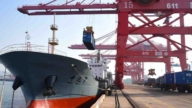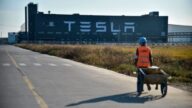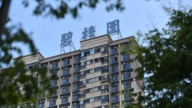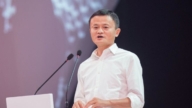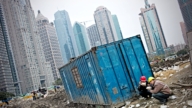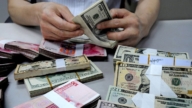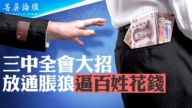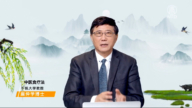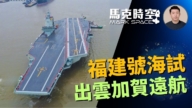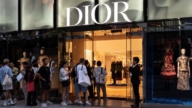【新唐人2014年08月06日讯】日前,大陆社科院一份报告指出,中国经济今年要保持7.4%增长,需20万亿资金支援,另外新增贷款规模,也可能首次突破10万亿大关。2008年全球金融危机后,中共靠“4万亿”投资拉动经济的模式,给中国带来的苦果还没有偿完,要达到中共总理李克强设定的,今年7.5%的GDP增长目标,中共势必还要以超过以往的规模,继续加大投资推动经济。来听听专家的分析。
中国社科院7月25号在北京发布“经济蓝皮书夏季号:中国经济增长报告(2013—2014)”。报告预测,今年经济增速为7.4%,是24年来最慢增速。
社科院经济所副所长张平表示,今年经济要保持7.4%的增速,没有20万亿资金下不来。
根据央行数据,今年上半年社会融资规模为10万5700亿元,比去年同期多4146亿元。其中,上半年人民币贷款增加5万7400亿元,同比多增6590亿元。
张平预计,今年社会融资总规模将达20万亿元,而新增贷款规模可能超过10万亿元,超过经济刺激力度最大的2009年,创出历史新高。
中国金融智库研究员巩胜利:“20万亿也很吓人,因为中国在2008年全球第一次金融海啸以后,一下子投了4万亿,4万亿到20万亿已经翻了若干倍了。”
大陆财经评论人士牛刀:“贷款超过10万亿。关键问题是,它在哪里拿那么多钱出来?现在拿的钱都是印钞的。印钞的钱是很危险的,印钞是一种负债,这种债务总有一天它要还。”
中国金融智库研究员巩胜利认为,造成中国货币投放居高不下的原因,是中国经济整体运行成本高,包括中国企业运行成本高、货币的成本高,还有党政运行的成本高。
大陆财经评论人士牛刀则表示,中共为了政权的利益,从来不按牌理出牌,采取的很多手段都是不正当的。
2008年金融海啸席卷全球,中国出口回落到负增长,工业生产大幅下滑,大量中小出口企业关闭、出现失业潮。当局担忧经济下滑可能动摇统治,出台所谓的“四万亿”经济刺激政策,“放水救市”。
美国“耶鲁大学”金融学教授、“博茂集团”首席顾问陈志武,在今年4月的“博鳌亚洲论坛”上说,“中国的4万亿,实际上不仅仅4万亿,就湖北一个省刺激方案就超过4万亿了。”他表示,这些钱已经造成了长期结构性破坏。
巩胜利:“当年中国投放货币4万亿,它不是以银行的形式投放的,而是以中国政府的形式投放的,这就告诉人们,中国的拉动经济是靠政府的投放。只要货币非常规的投放了,它就是一种放水。”
巩胜利分析,在拉动中国GDP增长的“三架马车”——投资、消费、出口中,今年以来,出口的比率一直在下降,而中国老百姓太穷,消费能力也非常低。
巩胜利:“唯一靠的是投资拉动,就是投放了大量的货币,拉动中国经济,没有投入,7.5的GDP是没有办法完成的。货币的投放是中国目前来讲实施最大的。”
数据显示,今年6月份中国广义货币M2暴增到14.7%。新增信贷在5月基础上延续高增长,并创五年来同期新高,社会融资规模环比也大幅上升。
大陆《21世纪经济报导》7月21号报导,央行对“国家开发银行”采用一种全新的有别于“再贷款”的货币投放方式——PSL(Pledged Supplementary Lending),也就是抵押补充贷款。注资万亿,用于支持所谓棚户区改造项目。
牛刀表示,中共“4万亿”过程中产生的产能过剩还没解决,现在又采取“再贷款”、“定向降准”、“调整存贷比计算口径”以及“回购商品房”等等各种手段,放水救市、加大投资拉动GDP,目地都是为了政权不垮掉。
巩胜利也表示,中国经济如果没有新的拉动,中国的GDP就会立刻掉下来,就会造成更多负面阴影,包括中国经济的稳定、和产业链的中断。
采访编辑/易如 后制/肖颜
Expert: China Economic Growth to Cost $3.2 Trillion to Keep
A recent Chinese Academy of Social Sciences (CASS) report
shows that China needs a $3.2 trillion stimulus package
to maintain a 7.4 percent economic growth rate this year.
Additionally, new loans may exceed the $1.6 trillion mark.
Debt still lingers from the 2008 financial crisis, when
$586 billion in stimulus was injected to boost the economy.
To reach the 7.5 percent GDP growth target set by Chinese
Premier Li Keqiang, the Chinese Communist Party (CCP)
has to increase the previous investment to boost the economy.
Let’s see what the economic experts are saying.
On July 25, CASS released its report on China’s economic
growth for 2013 to 2014.
The report says that this year’s economic growth rate
will be 7.4 percent, which is the slowest increase in 24 years.
Deputy director Zhang Ping of the CASS institute of
economics, says that the 7.4 percent economic growth rate
can’t be kept up this year without $3.2 trillion in capital.
According to China central bank, in the first half of this year,
the Aggregate Financing to the Real Economy (AFRE)
is $1.7 trillion, which is $67.1 billion more than last year’s.
Among them, loans in the first half year increased by
$928.9 billion which is $106.6 billion more than last year.
Zhang Ping expects the AFRE will reach $3.2 trillion this year,
while the new loans may exceed $1.6 trillion.
Loans will reach record highs and exceed those of 2009
a year which had the largest economic stimulus.
Chinese financial intelligence researcher Gong Shengli:
“$3.2 trillion is also very scary; because they once invested
$586 billion after the first global financial crisis in 2008.
From $586 billion to $3.2 trillion,
it has turned over several times. “
Niu Dao, China finance critic: “The loans exceed $1.6 trillion.
The key question is: Where does all that money come from?
Right now it’s all from printed money.
This is very dangerous because it’s a kind of liability.
This kind of debt has to be paid back one day."
Chinese financial think tank researcher Gong Shengli
says that the reason for such high money investment is
the overall high operational cost of China’s economy
including those of state-owned enterprises, a high money cost,
as well as the high operational costs of the Party.
Niu Dao says that most of the time the CCP uses unfair means
to gain political power, and has never played by the rules.
During the 2008 financial crisis, China’s exports fell
to a negative growth; the industrial production fell sharply,
and a large number of small and medium export enterprises
closed down, leaving behind a big wave of unemployment.
The authorities worried that the economic downturn could
destabilize the Party’s rule and so a $586 billion stimulus plan
was introduced.
This April, Chen Zhiwu, Permal Group chief adviser
and finance professor at Yale, said at the Asian Boao Forum
that it was not only $586 billion because the stimulus plan
in Hubei province alone exceeded $586 billion.
He said the money has caused long-term structural damage.
Gong Shengli: “The $586 billion investment
was not given by the bank, but by the Chinese government.
It shows the Chinese economy
depends on the government’s stimulus.
It’s a kind of economic drain
as long as it follows the unconventional money investment."
Gong Shengli says the three key aspects to stimulating China’s
GDP growth include investment, consumption and exports.
This year, the export ratio has been falling
while the Chinese people’s consumption is very low.
Gong Shengli: “The only way is to drive by investment which
is to put a lot of money to boost China economy.
Without investment,
this year’s GDP goal of 7.5 can’t be achieved.
Money investment is the most practical way for China so far."
Data shows that this June,
the Chinese broad money supply (M2) jumped to 14.7 percent.
New credit continues to have high growth based on May data,
and has reached its highest in five years.
The social financing scale ring has also increased significantly.
China-based 21st Century Business Herald reported on July 21
that China’s central bank is using a new tool — Pledged
Supplementary Lending backed by collateral.
PBOC stumilated trillions to support reconstruction project.
The central bank injected tens of billions of dollars,
reportedly to support the renovation of shantytowns.
Niu Dao: “They have no way to print $3.2 trillion;
but they will think of a way.
They’ve already got some ideas now."
Niu Dao says that the overcapacity from CCP’s $586 billion
investment still has not been solved.
They’re using refinancing, targeted Reserve Requirement Ratio
cuts, adjustment of loans to deposit ratio calculation method,
buy-back commercial housing, and so on to save the market
and increase investment-led GDP.
It’s all done to protect the regime from collapse.
Gong Shengli also says that without now injections
to China economy, China’s GDP will immediately drop.
It would cause more negative influences, including China’s
economic stability and industrial chain disruptions.
Interview & Edit/YiRu Post-Production/XiaoYan



